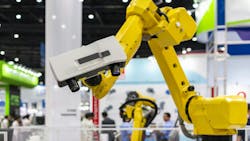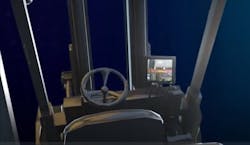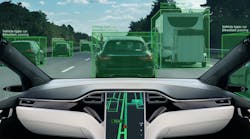COTS and OSS Promote Cost-Effective Custom Vision-System Design (Part 1)
This article is part of the TechXchange: Machine Vision.
What you’ll learn:
- Where COTS is used in machine-vision applications.
- Why open-source software (OSS) is making an impact on machine-vision systems.
Machine-vision systems are foundational in providing the “easy button” to perform tasks on the first attempt, something that otherwise would normally require years of skilled training. Thus, OEMs need an increasing number of sensors, software, and intelligent analytics to enable this level of automation.
The addition of machine-vision systems using artificial intelligence (AI) to equipment and devices helps further improve usability, safety, and efficiency for the end-user, and save facilities hundreds of thousands of dollars per year by avoiding unplanned downtime.
Of course, today’s consumers expect more technology and “ease of use” in their devices, appliances, equipment, and vehicles. For instance, many of us have benefitted from AI-based parking-assist functions on cars and facial recognition to unlock phones. So, it’s no surprise that industrial, medical, and commercial equipment manufacturers are looking to achieve similar advances for their professional-grade products.
The Systems We’ve Known
Machine-vision systems have existed and evolved for decades as manufacturers looked to replace tedious and error-prone manual processes with the efficiency of automation. Today, they hold a prominent place in manufacturing, where machine vision is, in many ways, the eyes of an operation—spotting defects, ensuring accuracy, and detecting anomalies, all at extremely high speeds and more consistently than a human operator (Fig. 1).
Due to the specialized nature of machine-vision systems, most companies use external developers for their advice, as well as supply these systems and related software and sensors for their manufacturing applications. But they’re not ideal partners to work with if you’re trying to add an easy button to a niche application, such as a forklift with positioning assistance, ground support vehicles with collision avoidance for airports, or object sorters for recycling facilities.
OEMs looking to improve these types of processes using vision systems will face three main barriers when working with major machine-vision developers:
- They are price-prohibitive for high volumes. A custom application can cost $5,000 to $10,000 per unit, plus software licensing fees and custom programming.
- New technology lags behind the consumer-like lifecycle of machine-vision components. This technology lag makes these canned vision systems seem to trail in performance, yet they cost substantially more.
- There is a tradeoff. Major machine-vision developers build their systems with specialized tools they create based on features desired by most of their customers. This approach provides flexibility at the front end because customers can select what features they want. However, customization beyond the choices already offered is difficult.
Turning to COTS Components and OSS
Manufacturers who choose to integrate a vision system into equipment they’re selling need a solution that’s affordable to produce in high volumes, easy to install, and manageable regarding backward compatibility and longevity.
A new crop of external developers is adapting commercial off-the-shelf (COTS) camera sensors and open-source software (OSS) to overcome the previously discussed barriers to create custom solutions. Low-cost OEM cameras can now capture 240 frames per second. When integrated with off-the-shelf PCs and graphics processing units (GPUs), a system can achieve the level of performance most would expect from high-end industrial vision systems, but at a much lower cost. Higher-volume, custom camera designs are even more cost-effective.
COTS components and OSS are creating opportunities for nearly any OEM in any industry to improve equipment design, device control, and operational outcomes using vision systems. Here’s how:
- They cost hundreds of dollars per unit and typically less than a few thousand dollars for the complete application, plus they have no software licensing fees. High-volume custom solutions can be less than a $1,000 for the entire system.
- Upgrade and migration plans can be built-in at the beginning and through a lifecycle management program that accommodates the entire supply chain, especially for niche and high-volume applications.
- Cameras and components are purchased and adapted if needed. Designers are developing analytics by leveraging shared successes and learnings from an open-source community made up of thousands of expert users.
Thanks to the unique ability to serve as building blocks to innovation, the custom innovation opportunities with COTS components and OSS are game changers. And taking it a step further, when supplemented with custom solutions from embedded technology experts, the possibilities are endless.
COTS Camera Sensors Keep Improving
About every 18 months, a new generation of consumer applications electronics comes to the market. The developers of these products continue to drive rapid improvement in COTS OEM cameras with better sensor quality, speed, and resolution. At the same time, prices are steadily dropping as more and more are being built and sold.
Not only are COTS camera sensors and components high quality and affordable, but they also are significantly more powerful than more expensive camera systems of the past. For example, the first cell phone with a built-in camera was the Sharp SCH-V200 flip phone, which came out in 2000 with an image resolution of 0.35 Mpixels. The average smartphone camera today has a 12-Mpixel resolution.
The latest camera sensors can improve patient outcomes when integrated into medical devices. Moreover, these sensors are able to read license plates at high speeds from any direction when incorporated into a police vehicle.
Custom solutions help add flexibility when, for example, a COTS camera is unavailable in the size or specifications needed. With supplemental custom design, vision systems can provide driver visibility to a forklift, reducing blind spots and improving accuracy.
Open-Source Software Opens New Possibilities for Product Development
The second article in this series will build on the key factors in the ideal camera for your application, as well as the innovation made possible by the help of OSS offered from outside developers. These programs usher in the ability to collect data from the camera and analyze it to establish trends, perform a function, or make a logical decision at a cost and timeline that’s less than in-house development (Fig. 2).
Read more articles in the TechXchange: Machine Vision.
About the Author

Kent Tabor
President and CTO, EmbedTek, LLC
Kent Tabor is president and founder of EmbedTek. He earned an Electrical Engineering degree from the University of Wisconsin-Platteville.



